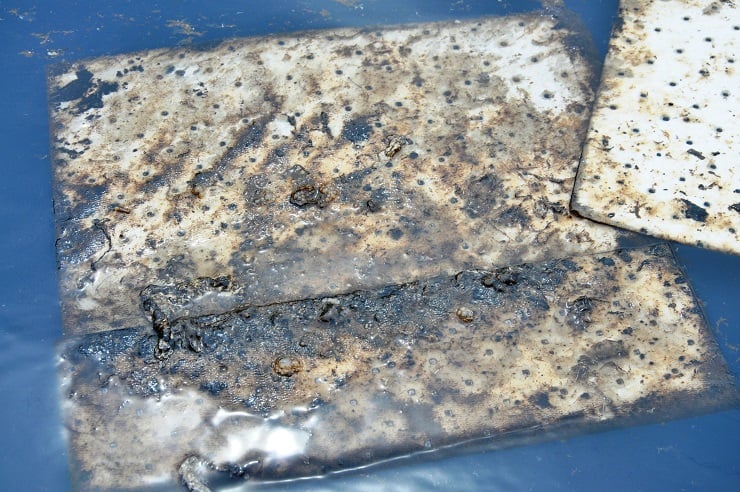
The Santorini shipwreck of the cruise ship MS Sea Diamond has been a permanent feature of the Greek island for the last 17 years.
The people of Santorini are still fighting for the removal of the wreck that has become a hot potato between stakeholders as it evolves into a silent environmental time bomb for the world-famous Greek island and its beautiful caldera.
The tragic incident took the lives of a French father and daughter and made international headlines for the difficult and dangerous evacuation of 1,195 passengers, mostly Americans and Canadians, on April 5, 2007.

In a letter sent to Parliament’s Special Standing Committee for Environmental Protection this week, Santorini’s residents are demanding the implementation of current legislation and relevant judicial decisions for the immediate removal of the ship.
“The shipwreck remains on the seabed and continues to pollute, at a slow but steady rate, it erodes daily and at any time it can cause an incalculable ecological disaster,” the letter said.
Loucas Lignos, a representative of local groups protesting the handling of the incident, told Greek Reporter recently, that both the owner of the ship and successive Greek governments have failed the community in not taking action to eliminate the looming environmental destruction stemming from the ship’s fully loaded fuel tanks.

Measures insufficient to counteract threat from shipwreck
Although superficial decontamination of the waters and nearby shoreline did take place in the months following the tragedy, and an unsuccessful pumping operation took place two years later, local people consider the ongoing containment measures insufficient to counteract the threat.
They have been pleading for the complete salvage and removal of the MS Sea Diamond from the caldera ever since.
They fear that the inevitable corrosion of its steel fuel tanks will cause an enormous fuel leak sooner or later, which would lead their pristine marine environment into catastrophe and devastate the island’s marine ecosystem.

Who is paying for the shipwreck’s removal?
“What is at stake, in this case, is who will pay for the process; the insurance company does not want to, neither does the ship-owner company and of course everyone is trying to avoid the removal, just as has happened with so many other shipwrecks in the Greek seas,” Lignos told Greek Reporter.
In 2014, the Civil Court of First Instance ruled in favor of the municipality of Santorini as it found the ship’s owner guilty of the incident and responsible for paying for the removal of the wreck whatever the cost, plus a few million euros in damages to the island’s local administration and the Greek state.
However, the company appealed the decision, and the procedure is still pending because of consecutive adjournments of the court.
While the Hellenic Centre for Marine Research regularly monitors the levels of sea pollution in the area, and a containment barrier is still in place around the sunken ship, plumes of oil regularly become visible on the sea’s surface whenever there is strong wind.
At one point, the barrier actually broke in 2018, allowing the contaminants to flow freely into the sea.

Pollution from the shipwreck
An independent expert report presented in court, drawn up by the Laboratory of Toxic and Hazardous Waste Management of the Technical University of Crete confirmed the worst fears of the Santorinians.
The known pollutants inside the Santorini shipwreck include hundreds of cubic meters of motor fuel and lubricants; hundreds of liters of battery electrolytes; copper cables; anodes containing heavy metals, and other dangerous chemicals — all taking an estimated 400 years to become inert.
“Any other delay or action (than the wreck’s removal) will result to the ecological destruction of the caldera, among other things” it concludes. A separate independent report reassures the public that the wreck is still fit for removal.
“I can’t say that we currently have tar or petrol oil on our beaches, or that we can’t swim, but I do notice oily mixtures surfacing from the shipwreck daily. Someday, the tanks will break open and much more fuel will come out from whatever is inside MS Sea Diamond,” Lignos explained to Greek Reporter.

The Santorini man’s despair becomes even greater when he recalls how the protracted dispute came very close to resolution recently.
Protracted dispute over Santorini shipwreck
The citizens’ initiatives won a separate case at Greece’s Supreme Administrative Court, the Council of State, which ordered the Ministry of Shipping and Island Policy to step in and take immediate action for the Santorini shipwreck, then go after the shipowner for the expenses.
Soon after, island residents rejoiced at the news of an international bidding process opening up by the Ministry and of offers having been submitted by two reputable Chinese wreck removal companies.
However, this led to another letdown again, a few weeks later, as they discovered that not only had the tender been canceled, but its organizing body, the Public Port Authority, would itself be dismantled.
The Ministry, Lignos said, has since claimed that the wreck’s removal should be handled by the Municipal Port Fund of Santorini — a local administrative body operating on a minimal budget and workforce, without any legal or engineering staff capable of either overviewing such a gigantic venture or going after the shipowner to claim the incurred costs.

“It’s just not possible that they (officials) have stayed inactive and done nothing on this case, essentially letting the time go by in the interest of the ship-owner.
“Because when twenty or thirty years will have passed, they’ll tell us, you know what, the ship is now rusted and the metal won’t survive being lifted up by the cranes. So leave it there and any time that fuel surfaces, we’ll come clean it up,” Lignos lamented.
See all the latest news from Greece and the world at Greekreporter.com. Contact our newsroom to report an update or send your story, photos and videos. Follow GR on Google News and subscribe here to our daily email!



